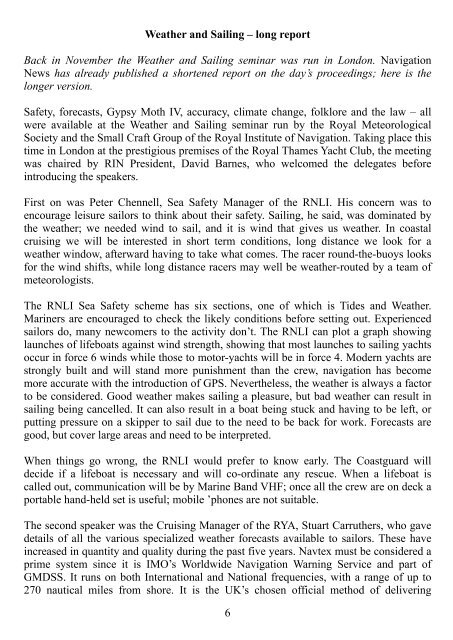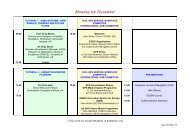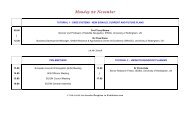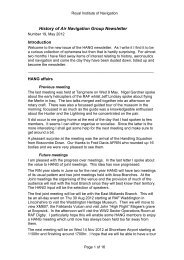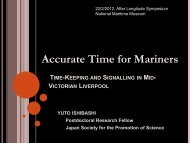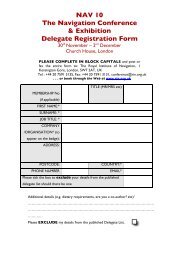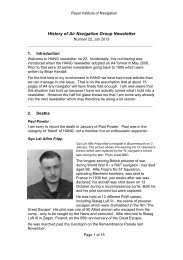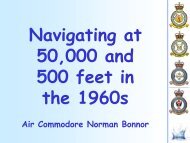Fairway 30 - Royal Institute of Navigation
Fairway 30 - Royal Institute of Navigation
Fairway 30 - Royal Institute of Navigation
You also want an ePaper? Increase the reach of your titles
YUMPU automatically turns print PDFs into web optimized ePapers that Google loves.
Weather and Sailing – long report<br />
Back in November the Weather and Sailing seminar was run in London. <strong>Navigation</strong><br />
News has already published a shortened report on the day’s proceedings; here is the<br />
longer version.<br />
Safety, forecasts, Gypsy Moth IV, accuracy, climate change, folklore and the law – all<br />
were available at the Weather and Sailing seminar run by the <strong>Royal</strong> Meteorological<br />
Society and the Small Craft Group <strong>of</strong> the <strong>Royal</strong> <strong>Institute</strong> <strong>of</strong> <strong>Navigation</strong>. Taking place this<br />
time in London at the prestigious premises <strong>of</strong> the <strong>Royal</strong> Thames Yacht Club, the meeting<br />
was chaired by RIN President, David Barnes, who welcomed the delegates before<br />
introducing the speakers.<br />
First on was Peter Chennell, Sea Safety Manager <strong>of</strong> the RNLI. His concern was to<br />
encourage leisure sailors to think about their safety. Sailing, he said, was dominated by<br />
the weather; we needed wind to sail, and it is wind that gives us weather. In coastal<br />
cruising we will be interested in short term conditions, long distance we look for a<br />
weather window, afterward having to take what comes. The racer round-the-buoys looks<br />
for the wind shifts, while long distance racers may well be weather-routed by a team <strong>of</strong><br />
meteorologists.<br />
The RNLI Sea Safety scheme has six sections, one <strong>of</strong> which is Tides and Weather.<br />
Mariners are encouraged to check the likely conditions before setting out. Experienced<br />
sailors do, many newcomers to the activity don’t. The RNLI can plot a graph showing<br />
launches <strong>of</strong> lifeboats against wind strength, showing that most launches to sailing yachts<br />
occur in force 6 winds while those to motor-yachts will be in force 4. Modern yachts are<br />
strongly built and will stand more punishment than the crew, navigation has become<br />
more accurate with the introduction <strong>of</strong> GPS. Nevertheless, the weather is always a factor<br />
to be considered. Good weather makes sailing a pleasure, but bad weather can result in<br />
sailing being cancelled. It can also result in a boat being stuck and having to be left, or<br />
putting pressure on a skipper to sail due to the need to be back for work. Forecasts are<br />
good, but cover large areas and need to be interpreted.<br />
When things go wrong, the RNLI would prefer to know early. The Coastguard will<br />
decide if a lifeboat is necessary and will co-ordinate any rescue. When a lifeboat is<br />
called out, communication will be by Marine Band VHF; once all the crew are on deck a<br />
portable hand-held set is useful; mobile ’phones are not suitable.<br />
The second speaker was the Cruising Manager <strong>of</strong> the RYA, Stuart Carruthers, who gave<br />
details <strong>of</strong> all the various specialized weather forecasts available to sailors. These have<br />
increased in quantity and quality during the past five years. Navtex must be considered a<br />
prime system since it is IMO’s Worldwide <strong>Navigation</strong> Warning Service and part <strong>of</strong><br />
GMDSS. It runs on both International and National frequencies, with a range <strong>of</strong> up to<br />
270 nautical miles from shore. It is the UK’s chosen <strong>of</strong>ficial method <strong>of</strong> delivering<br />
6


